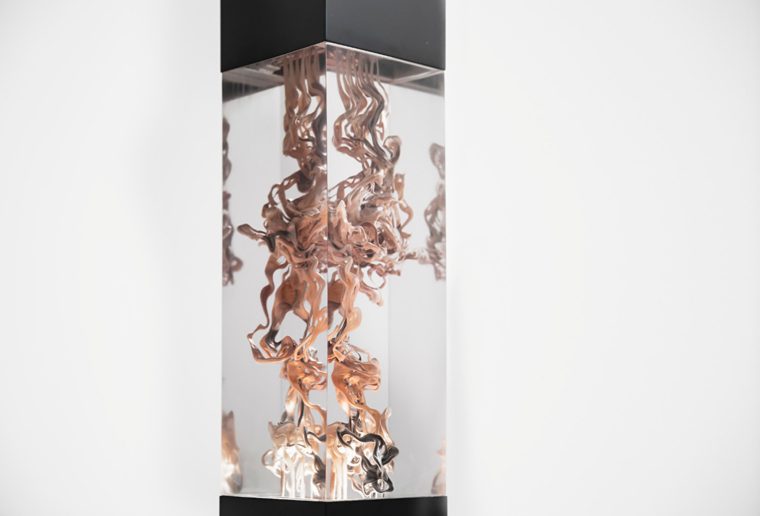Demonstrating the creative opportunities achievable when harnessing 3D printing within art and design, Stratasys (Nasdaq: SSYS) has announced two new projects made possible with support of acclaimed designer Neri Oxman and The Mediated Matter Group.
The first, Aguahoja – comprising Aguahoja I and the forthcoming Aguahoja II – was conceived in commemoration of the UN’s recent World Water Day.
The project is a collection of artefacts made almost entirely out of organic matter and shaped by water. The works aim to subvert this cycle through the creation of biopolymer composites that exhibit tuneable physical and environmental properties in ways that are impossible to achieve with their synthetic counterparts.
Aguahoja I includes three artefacts, the central piece of which is an ‘architectural pavilion,’ a 5m-long spinal structure comprising 95 individual 3D printed segments. Produced by Stratasys Direct Manufacturing (SDM), and supported by Stratasys Ltd., the F900 3D Printer was selected as the ideal technology to manufacture the pavilion’s large-scale and complex geometry given its extremely large build size capability. However, assembling such a tall and complicated structure presented a challenge – as a result a series of custom fixtures were printed to hold each individual component together. Chosen for its superior mechanical properties and aesthetic appearance, the robust ASA material provides the necessary rigidity to keep the entire structure stable, while also housing organic matter.
“The support from Stratasys to the Aguahoja project offered my team and I the unique capability to design complex shapes that ensure the structure’s geometric stability, while also faithfully upholding the organic integrity that is central to the project’s theme,” explains Neri Oxman. “The ability to quickly iterate the design throughout the project using 3D printing enabled us to optimize the structure and aesthetics of the pavilion in a way not possible with traditional techniques.”
Aguahoja II will comprise a second pavilion and associated artifacts. Co-organized by the Cooper Hewitt, Smithsonian Design Museum and Cube Design Museum in Kerkrade, Netherlands, Aguahoja II will be on view from May 10th, 2019 to January 20th, 2020. The works will revisit the design issues in the context of Material Ecology – the Group’s design approach and philosophy.
Totem – chemically synthesizing the ‘pigment of life’
In addition to Aguahoja, Stratasys provided support to Neri Oxman and The Mediated Matter Group on the creation of a second project, entitled Totem. This follows on Stratasys’ earlier support of Neri Oxman, including the widely-acclaimed mask collection, Vespers, announced in 2016. Totem seeks to address and speculate upon designers’ ability to chemically synthesize the ‘pigment of life,’ melanin, — literally and metaphorically — and program its interaction across scales and species.
Totem has been designed for Broken Nature: Design Takes on Human Survival, an exhibition curated by Paola Antonelli that explores concepts such as ‘respectful,’ ‘restorative’ and ‘reclaimed’ design, pointing towards the tension between the built and the grown. The exhibition is running at the XXII Triennale di Milano in Italy from March 1st until September 1st, 2019.
Totem features a demonstration of melanin production on an architectural scale for deployment in specific environmental contexts. Included in the project is an architectural proposal for an environmentally responsive melanin-infused glass-like structure.
The piece is designed with a complicated, vessel-like interior void structure to contain multiple types of melanin, including the replication of a natural melanogenic process observed on site and biological synthesis or extraction processes performed at the Lab. To ensure the utmost optical clarity, the channels in the glass structure within which the melanin is housed, were 3D printed using a novel transparent digital material from Stratasys.
However, to produce such intricate and winding channel structures, an advanced liquid support material was used during the printing process. Once the entire model was 3D printed, the liquid support material was washed away leaving finely-detailed hollow structures to house melanin – a first-of-its kind in 3D printing and the only way that this design could have been produced.
“One of the key criteria for Totem was the need to securely contain the melanogenic structure without compromising the ability to flawlessly promote every level of visual detail. As a result, we used an advanced transparent 3D printing material that can simulate the clarity of glass, enabling a clear visualization of the internal components and features,” explains Neri Oxman.

 Deutsch (Germany)
Deutsch (Germany)  Polski (PL)
Polski (PL) 










